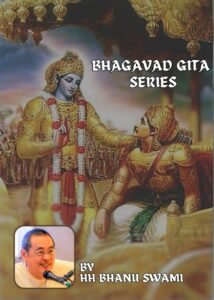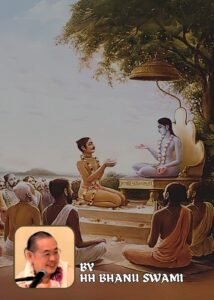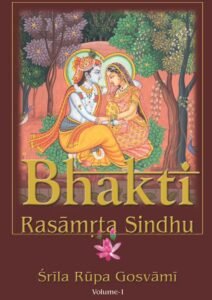Rasa Part 5 By HH Bhanu Swami Maharaj | ISKCON Japan | Jan 11, 2022
Okay, so anyway, what we’ve done so far is we’ve done the first element of rasa as Vibhava. So Rupa Goswami has one chapter for each of the elements. So he has the Vibhava’s first chapter, second chapter is Anubhava, next chapter is Sattvikabhava, fourth chapter is Vyabhicari Bhava, and the last chapter is Sthayibhavas.
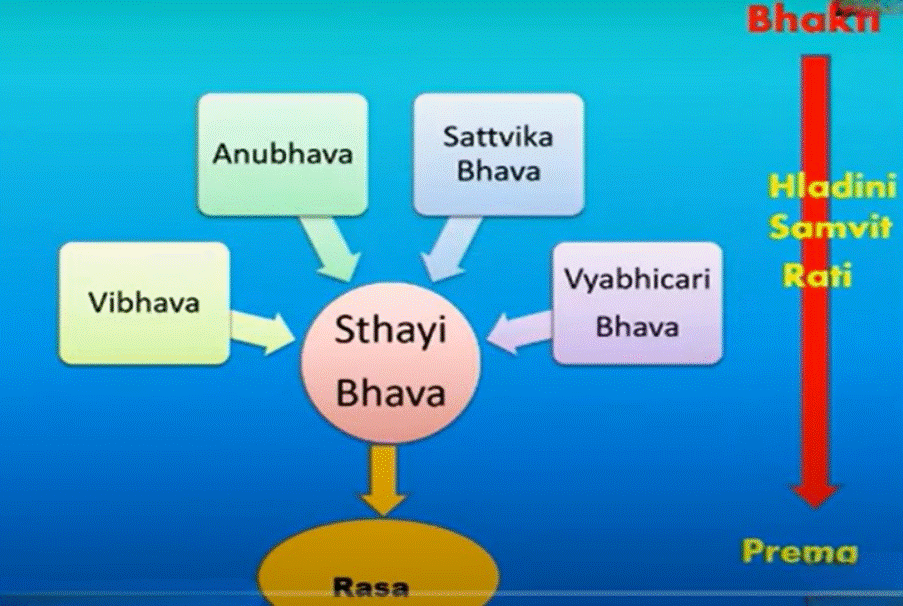
So I’ll go very quickly over the Anubhava’s, Sattvicabhava’s, and Vyabhicari Bhava’s because they’re a little bit detailed and we’ll go on to the after that we’ll go on to other things.
Anubhavas:
Okay, so let’s cover Anubhavas. So the definition is Anubhava means those things, actions which express the emotion within the heart. And they’re by and large external, they manifest and they’re visible.

2 types of Anubhavas:
So they’re classified technically into two parts, those with less bodily movement called ‘Sita’, and those with more prominent bodily movements called ‘Ksepana’.

- Sita (5 types):
Okay, so the Sita ones are things like singing, yawning, breathing heavily, disregarding others, drooling and smiling.

2. Ksepana (8 types):
And the Ksepana – is things like dancing, rolling on the ground, shouting, stretching the body, bellowing, laughing loudly, whirling around and having hiccups. So these are very general Anubhavas. But in each Rasa there are more particular Anubhavas.

So these will be described when Rupa Goswami describes the different Rasas. But for instance if we have Sakya Rasa, one of the Anubhavas is wrestling with Krishna, or playing or herding the cows with Krishna. So these are Anubhavas.
So they are not emotions but they arise because of emotions, because of love for Krishna. Or for instance Mother Yasoda, her Anubhavas are bathing Krishna, or cooking for Krishna, or serving Krishna food. So Rupa Goswami just gives examples of each of these aspects, each of these Anubhavas, the general ones.
1.Dancing (ksepana):
So for dancing he gives the example of Lord Shiva. So when Krishna played His flute, Shiva heard that, he began trembling, and then he began dancing along with Ganesh. So he’s dancing because he has an emotion of joy, and the joy arises from hearing Krishna’s flute.
So the dancing is an expression of his joy.

So actors also, they can express themselves in various ways. So they can use words, say I’m very happy [Laughs]. But they can also have expressions on their face. Or when the emotions are strong, then they can express those emotions and actions. And by seeing those actions, then the audience can understand, oh yes, he is joyful.
2. Rolling on the ground (ksepana):
Okay, so another one of these Anubhava’s is rolling on the ground or falling on the ground. So for instance, this is an example of Radharani, because she’s so attracted to Krishna, she falls down on the ground.
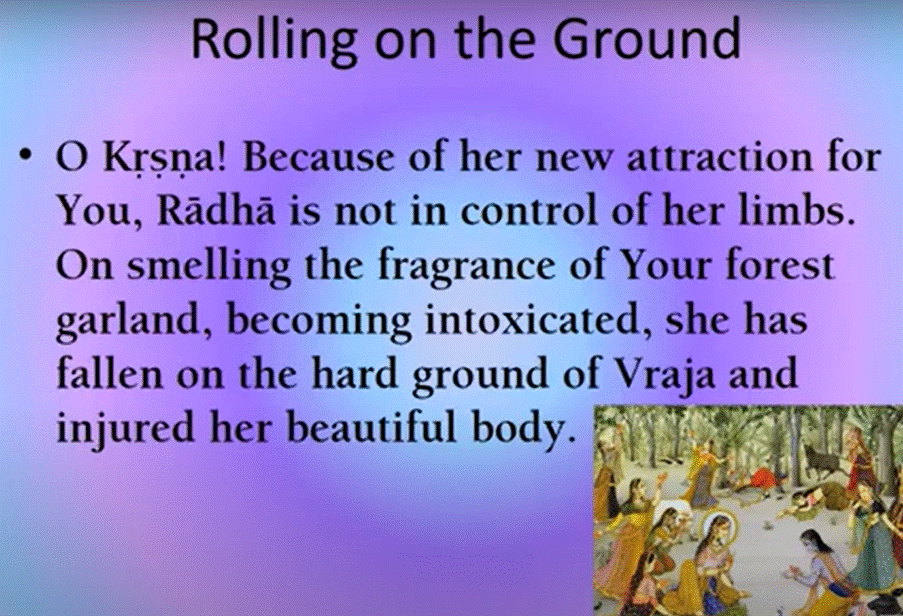
3. Shouting (ksepana):
So an example of shouting is Narada Muni. So he began chanting Krishna’s name. But then he got so excited from chanting that he began shouting very loudly. And it was so loud that the demons got frightened and ran away.

4. Stretching the body (ksepana):
So another action is stretching of the body. This is an example of Narada Muni, because he was singing Krishna’s name, he got so joyful that he stretched his body so much that his thread broke, the sacred thread broke.
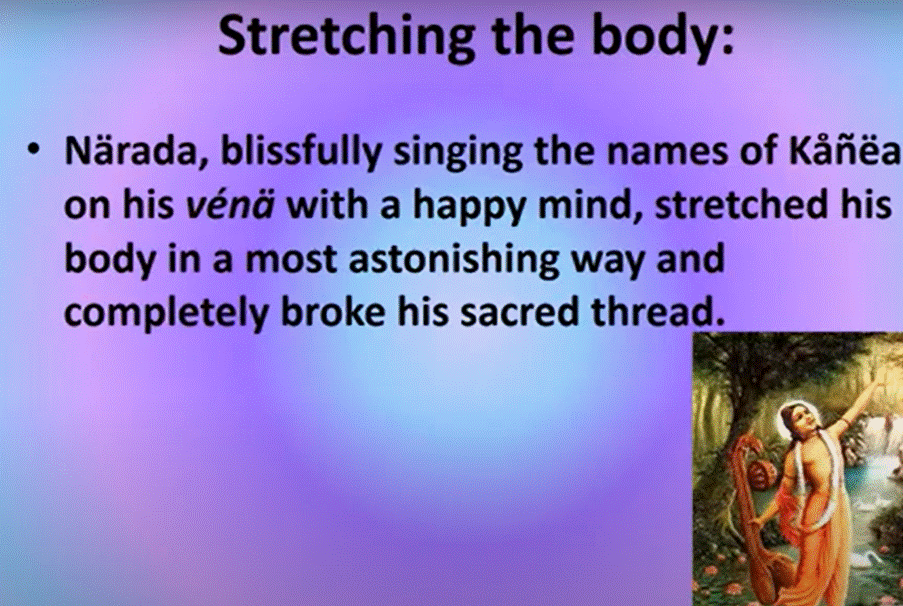
5. Making loud noises, roaring or bellowing (ksepana):
So Shiva, he heard the Vina of Narada Muni, and then he got so excited, he began roaring like an elephant.

6. Loud laughing (ksepana):

7. Hiccups (ksepana):
So that was hiccups [Laughs]. So this is not so voluntary, usually hiccups, but when the devotees become very emotional, sometimes they have hiccups. So Radharani, because of love of Krishna, then she started hiccuping.
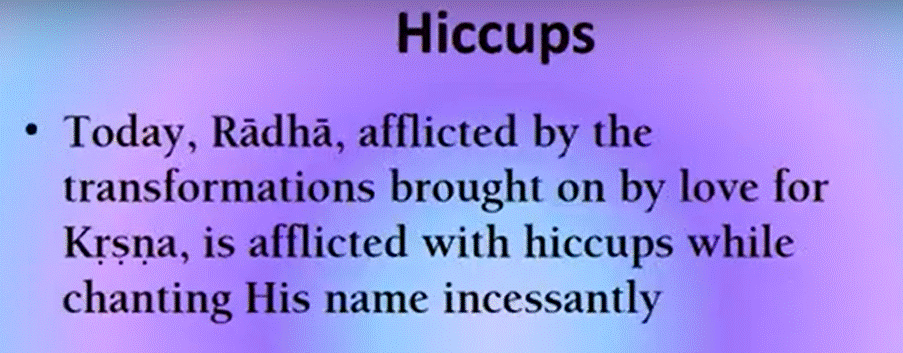
8. Whirling around (ksepana):
Turning the body around. So the example here is that the women start to whirl around.
And that happens because they hear the sound of a flute.
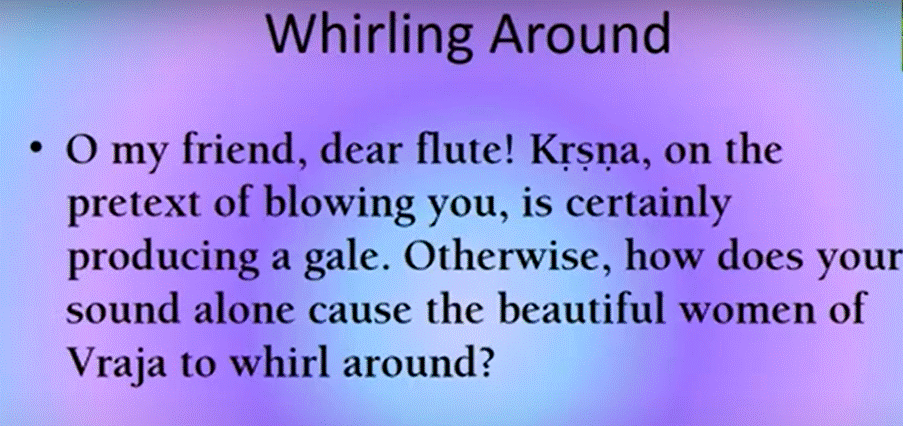

1.Yawning (sita):
So Radha also began to yawn on thinking of Krishna.

2. Singing (sita):
So out of love for Krishna, Radharani starts singing songs.

3. Heavy breathing (sita):
So when Krishna arrives, then Radharani starts breathing heavily.

4. Disregard for others (sita):
So when the Gopis fall in love with Krishna, they ignore their husbands, they ignore their parents.

5. Drooling (sita):
So Narada Muni, out of Prema, then he began to drool [Laughs].

Sattvika Bhavas:
So the definition is, when the heart becomes overwhelmed by rati or bhava or some emotions in relation to Krishna, directly or indirectly, this is called sattva, that emotion, that deep emotion is called sattva. So the sattva then starts transforming the body. So that transformation is called the Sattvika bhava.

So we can say it is external symptoms arising because of intense internal emotions [Laughs]. So like the Anubhavas, they are also external.

But the Anubhavas have a little bit of conscious intention behind them, like singing. We have to think about it, then we sing. But the Sattvika bhavas, they just arise without our thinking about them at all. They are spontaneous.
3 types of sattvika bhavas:
Okay, so the Sattvika bhavas can be divided into various groups, but we won’t deal with that too much. We have the Snigdha, which is direct rati, Digdha, indirect, and Ruksha, which is false.
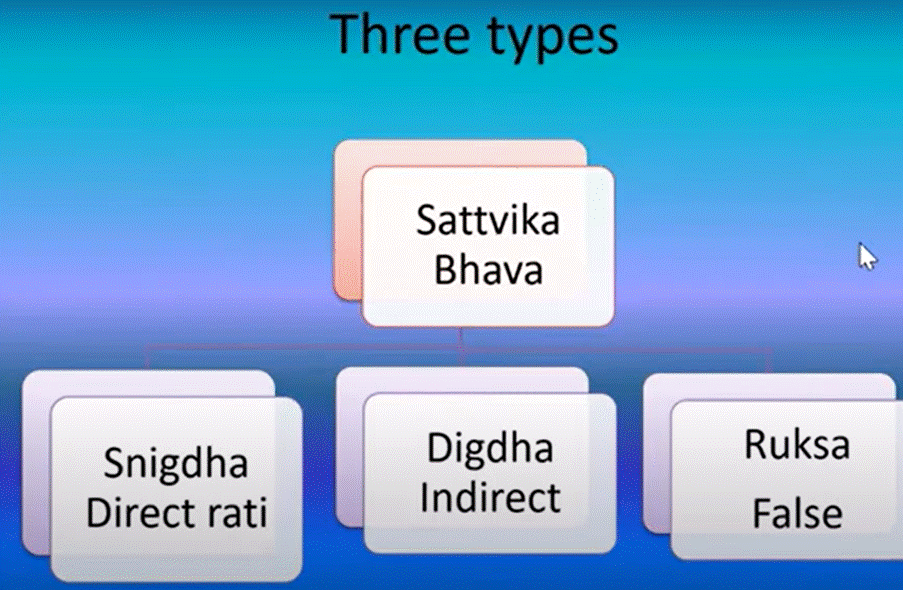
1. Snigdha Sattvika bhava:
So the Snigdha, the direct ones arise from Primary Rati or Secondary Rati. So we have the five primary ones like Santa or Dasya, Sakya, Vatsalaya, Madhurya. We have secondary ones like laughing or fear or anger.
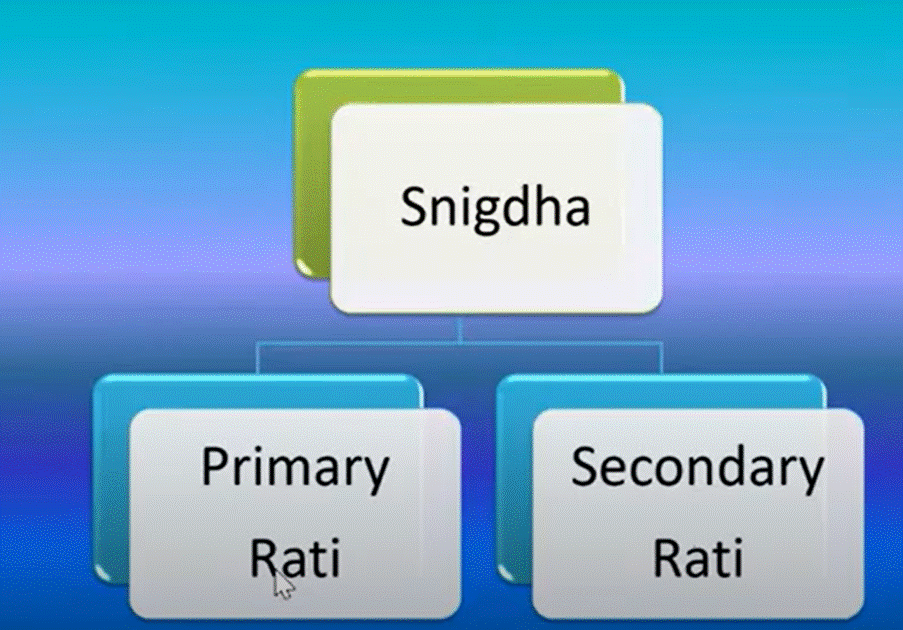
Okay, so this is an example of a primary rati, which is direct, a Snigdha. So Radha was making a garland, a jasmine garland for Krishna. And then she heard Krishna’s flute. And when she did that, she got paralyzed. She became completely stunned. She couldn’t move suddenly. So obviously because of her, she heard the sound of Krishna’s flute, her love was evoked and then suddenly, without thinking, she got paralyzed. She couldn’t do anything.

Okay, so here’s an example of a secondary rati. When Krishna went to Mathura, then Yasoda got very angry at Nanda Maharaj for taking him there. And her face turned red. And then her voice choked up. And she began to scold Nanda Maharaj. So the secondary rati here is anger. And then the Sattvika bhava says change of color and choking of the voice.
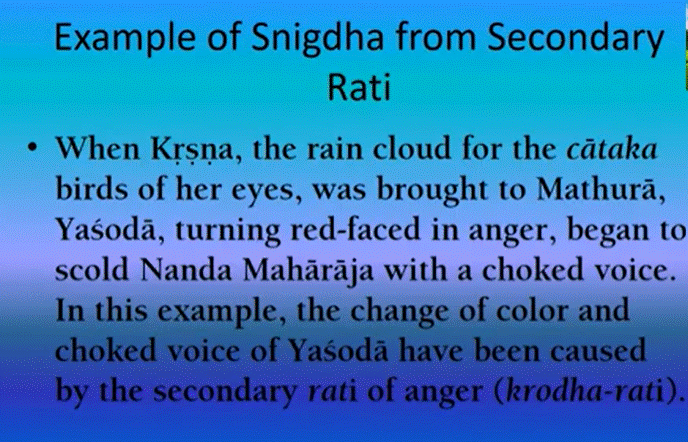
2. Digdha Sattvika Bhava:
Sometimes we get an emotion that’s not a primary or secondary rati, but the person does have you know attraction or love of Krishna. So that is called the Digdha Sattvika Bhava.

Yasoda has love for Krishna, so she’s a devotee. Then she had a dream at night, and in the dream she saw Putana. And then she began shaking [Laughs], trembling. That’s the Sattvika bhava. And then she went out searching for Krishna.
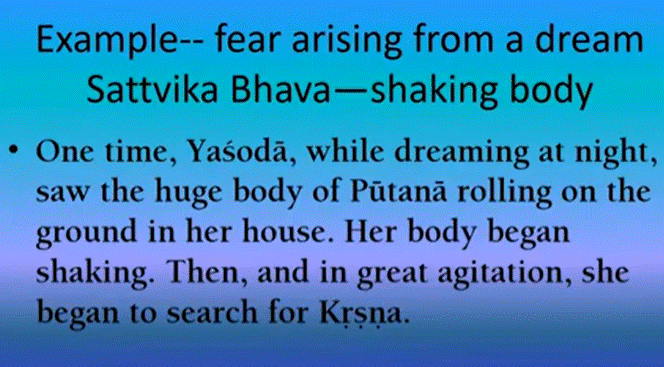
3. Ruksha Sattvika bhava:
Then we have the Ruksha Sattvika bhava. So sometimes people don’t have any attraction for Krishna, but they will manifest Sattvika bhavas.
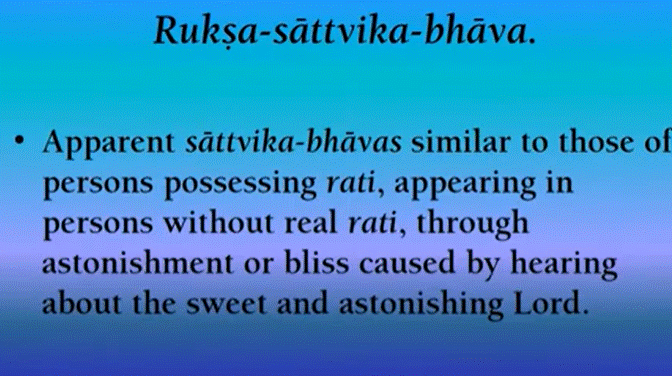
8 common Sattvika bhavas & how it manifests spontaneously:
Okay, so the eight Sattvika bhavas are here, being stunned or paralysis is one, perspiration is another, hair standing on end, choking of voice, trembling, changing of color, tears, and fainting. These are the common ones.

If you read Srimad Bhagavatam, particularly 10th Canto, and when they describe the different devotees, you’ll see that all these different symptoms begin to manifest at different times.
Science behind the manifestation of various sattvika bhavas:
So the first one is paralysis or stamba, it’s called. Okay, so the heart becomes overwhelmed with an emotion, this affects the pranas, the prana affects the earth element in the body, and this causes paralysis.

Okay, tears, crying, the heart affects the pranas because of emotions, this affects the water element in the body, water becomes disturbed, and then you cry, tears come out.
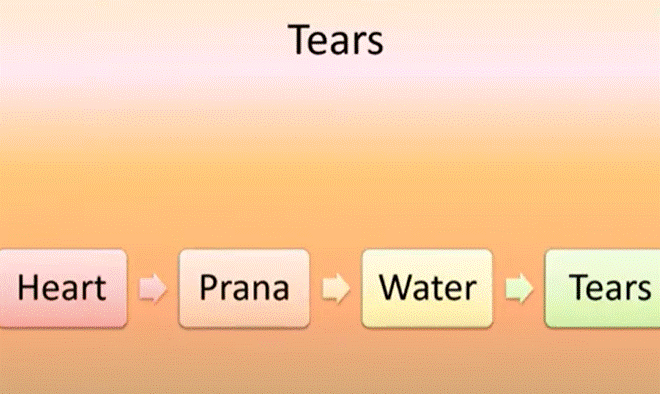
Perspiration and change of color, the heart gets affected, affects the pranas, this influences the fire element in the body, then you get perspiration and change of color.
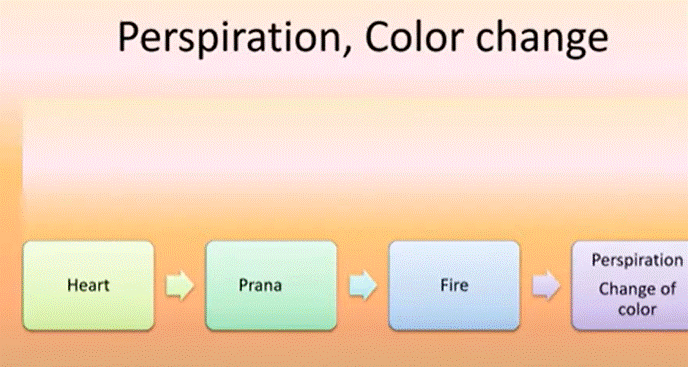
Then we have the heart gets affected, affects the pranas, this affects the ether element in the body, and then one faints.

Okay, the heart gets emotion, affects the pranas, this affects the air element, and then you get hair standing on end, trembling of the body, and choking of the voice.

Okay, so the Sattvika bhavas is because of the internal disturbance, and then they cause external disturbance also.

Okay, so the internal disturbance is called the Vyabhichari aspect, and the external disturbance is called the Anubhava aspect.

Emotions which trigger various sattvika bhavas:
1.Paralysis:
Okay, so going back to Stambha, which is paralysis, this arises, it can arise from joy, from fear, astonishment, disappointment, and indignation.

The action senses like the voice and the hands and the feet cannot move, and even the knowledge senses like the eye and the ear, don’t function properly. However, the mind is still active, so you’re still conscious.
So this is an example from the Bhagavatam, so the gopis, after they had past times of laughing etc., with Krishna, following with their eyes, then they sat down and they couldn’t do anything. They couldn’t do their household duties. They couldn’t do anything after that.

2. Perspiration:
Perspiration may arise from joy, fear, or anger. The body becomes damp.

So this is an example of Radharani. Someone looks at Radharani and she began to perspire [Laughs]. The reason for that is that she sees Krishna in front of her. So because of that emotion of love, then she’s perspiring.

3. Standing of hairs on end:
Standing of hairs on end can take place from astonishment, joy, enthusiasm, and fear.

Okay, this is an example of Yasoda. She looked in Krishna’s mouth and she saw the whole universe there. And then suddenly her hair stood on end. That’s because of astonishment.
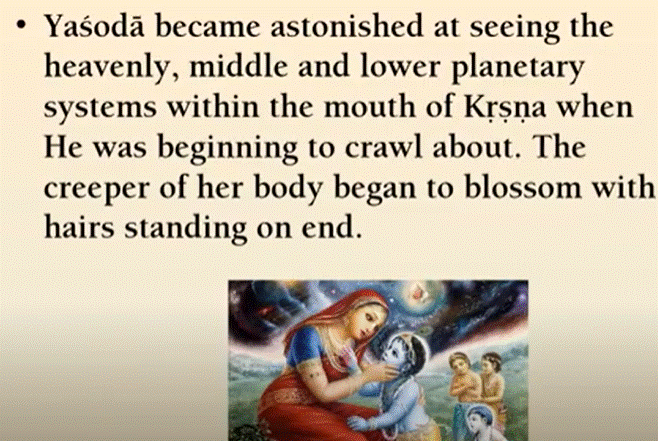
4. Choking of the voice:
This arises from sorrow, astonishment, anger, joy, and fear. When this happens, then you cannot speak properly. The words become all distorted.

Okay, so when Krishna was about to leave Vrindavan and go to Mathura, then Radharani was telling Yasoda to take Krishna off the chariot.

But her voice choked up and she couldn’t say the words properly. That was because of sorrow.

5. Trembling:
Trembling, shaking of the body. So that’s out of extreme fear, anger, or joy. So when Shankhachuda appeared, the big demon, and he was going to grab Radha, she in fear, she began to tremble.

6. Change of color:
That’s because of grief, anger, or fear.

So when Krishna lifted Govardhana Hill, Indra’s face became black. So the black face indicates his fear.
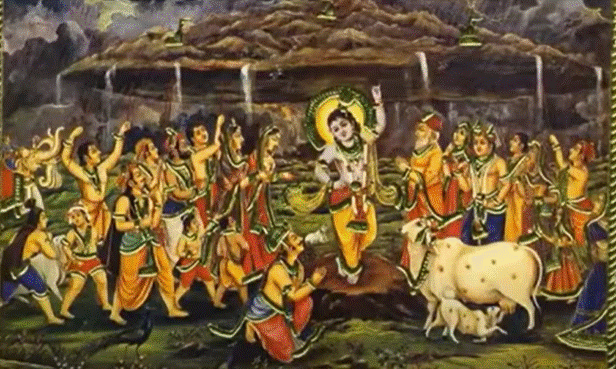
7. Tears:
When water comes out of the eyes, it comes out of joy, anger, or grief.

Tears that come from joy are cool, and tears that come out of anger are warm, or hot, hot water [Laughs…]
8. Fainting:
This means no actions of the body, and even your mental functions can’t operate. Because of happiness, or because of distress.

So when Krishna left Vrindavana, his description of how all the gopis were completely fainting all the time.

Degrees of Sattvika bhava:
So the Sattvika bhavas can be of various intensities. And the more intense the rasa, or the devotee, then the more intense the Sattvika bhavas become.
So the gopis with Madhurya Rasa have the most intense feeling for Krishna, so they have the most intense Sattvika bhavas. And of all the gopis, Radharani has the most intense Sattvika bhavas.
Okay, so the weakest form is called Dhumayita, or smoky, so that’s a weak type of Sattvika bhava. The next more stronger is called Jvalita. When it is stronger, it comes Dipta, very bright, very obvious.
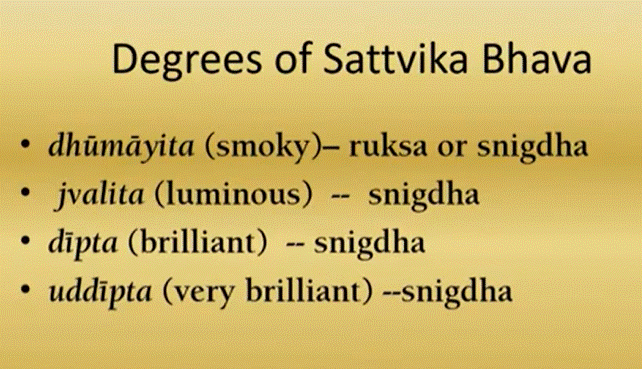
1.Smoky / Dhumayita
So the smoky ones / the weak ones, will manifest for a short period of time, and you can suppress them, you can hide them.
So an example here is the, I think the women in somewhere else, not in Vrindavan, elsewhere, they came out of the houses to see Krishna, and they began to cry, but then they stopped their tears, they were able to stop those tears, so that means the Sattvika bhava was weak.

2. Luminous / Jvalita:
When two or three Sattvika bhavas occur quite clearly, and only with great difficulty, they can be concealed, that’s called the Jvalita Sattvika bhavas.

So this is an example of several of these bhavas combining. So when your flute sound comes into the forest, and I hear it, my hands begin to shake, so that’s one subject about trembling. And then my eyes fill with tears, another Sattvika bhava. And then the legs become paralyzed, you can’t even walk, the third Sattvika bhava.

3. Brilliant / Dipta:
Okay, so the next one is called the Dipta Sattvika bhava. Three, four, or five Sattvika bhavas appear very strongly and cannot be concealed at all.
So, Narada saw Krishna, then he lost complete control, and he began to tremble. He couldn’t play his vina, in other words he was paralyzed. His voice was choked up, so he couldn’t say anything, he couldn’t sing anything. And then tears filled his eyes. So he had four Sattvika bhavas.

4. Very brilliant / udipta:
So Sattvika bhava, the Udipta, that’s a very bright one, is five, six, or all, all eight Sattvika bhavas will manifest.

So this is a description here of the people of Gokul, they are perspiring on separation.
Their limbs are paralyzed and their hairs are standing on end. Their voices are choked up. Their faces become pale. And they begin crying. And then they faint.

5. Intensely brilliant / sudupita:
Okay, so then we have another stage, it appears in Mahabhava, that’s called Sudipta Sattvika bhava. So all eight will manifest in the most intense form. This only manifests in Radha and her close associates or Sakhis.
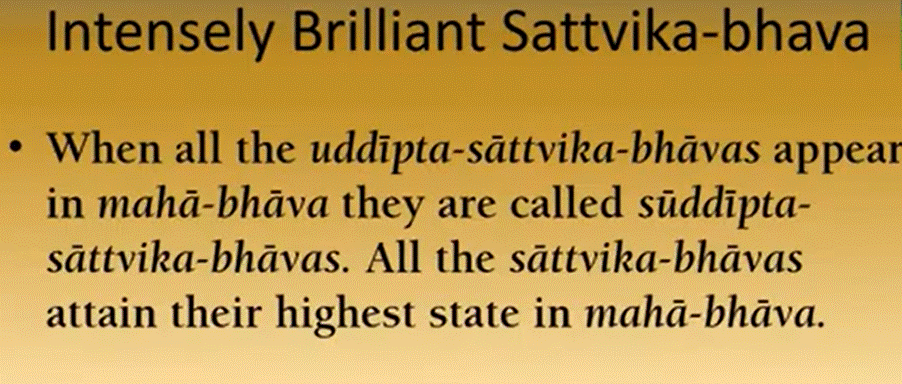
Sattvika bhava abhasas:
Okay, so now we have the Abhasas of Sattvika bhavas, false Sattvika bhavas. The person does not really have Prema or even Bhava, but they may manifest symptoms. So these may manifest in people who are desiring liberation, like Jnanis.

- Impersonalist / Jnani:
So an example is given of someone living in Varanasi, some Sannyasi or someone who worships Shiva and is meditating on impersonal Brahman. And so they glorify Krishna or Vishnu, and their hairs stand on end and they cry. So this is an Abhasas because they’re not devotees at all. So how can they have Bhava or Prema? They don’t have either, but they cry and their hairs stand on end.

2. Favorable to Krishna (but not a devotee & not an impersonalist):
But then maybe other people who are not impersonalists, they’re favorable to Krishna, but they don’t have Bhava or Prema, but they have a nice sentiment for Krishna. So they may get a shadow of these Sattvika bhavas.
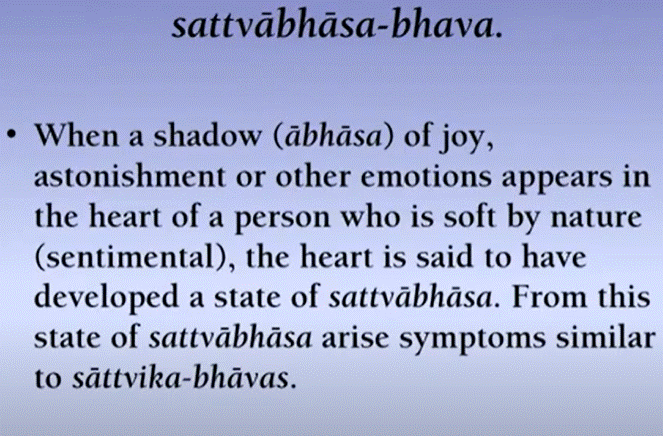
So an example is given of some old person who is an expert in Mimamsa scriptures, probably Karma Mimamsa or whatever and he heard the pastimes of Krishna. He became very joyful, his hairs stood on end. So he’s not a real devotee, but he’s also not opposed to Krishna.

3. Actors:
Then we have something called Nihsattva. This is a person who is completely hard-hearted, whatever, but he practices acting Sattvika bhavas, like crying and fainting.

4. Pretenders:
So then we have another form. This, of course, we can say are pretenders. These type of people are pretenders or actors or whatever like this.
5. Enemies of Krsna:
Then we have something called Pratipa Sattvika bhavas. Pratipa means enemies. So the enemies of Krishna have fear or anger of him, and they will show Sattvika bhavas sometimes.
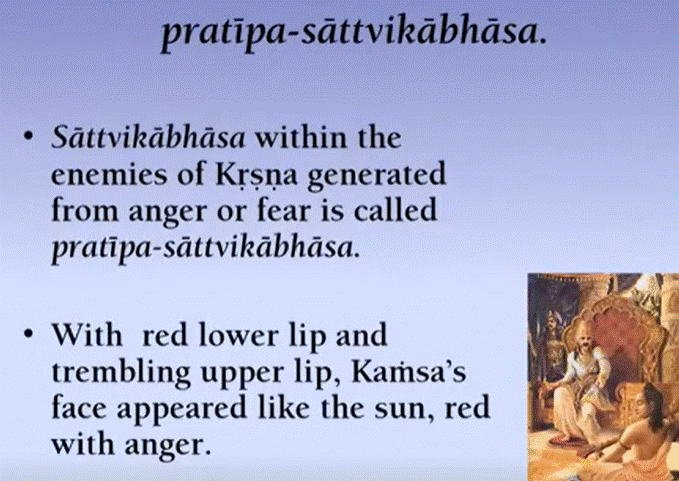
They may change color. They may tremble. They may perspire, etc. They may even faint or whatever out of intense emotions, but they have no Bhava for Krishna at all. They actually hate him. So Kamsa, for instance, he began trembling. His lips became red.
His face became red in anger. So this is not a real Sattvika bhava.
So in Bengal, these Sattvika abhasas may be quite common [Laughs]. We have Kirtaneyas who are not in Prema or Bhava, but they do this profession. So they cry, and they faint, and they roll on the ground [Laughs]. So this is called Sattvika abhasa.
So that’s the end of that chapter. So we covered two chapters today. Any questions ?
Q&A
Translator Devotee: I had one question from someone. They asked me to ask. I think this was from previous lecture. I’m just looking for it. They wanted to know if it’s like
1) When we are trying to understand these spiritual Rasas or Rathis, is it appropriate to try to understand them or measure them with material examples or analogies? Like, should we use our own experience that are material to try and understand like spiritual relationships and things?
Well, I may have mentioned previously that Rupa Goswami drew his analogies from or his terminologies actually from material Rasas, which were depicted by you know Bharat Muni and others in material dramas. And they started analyzing into Sattvika Bhavas, Anubhavas, Sthayi Bhava, etc. So then he used the same terminologies to apply to spiritual Rasa. So there is a similarity there.
So they operate in a similar way. We’ll have the Sthayi Bhava, and then out of that, we’ll get Anubhavas and Sattvika Bhavas and Vyabhachri Bhavas, etc. So in that way, they’re similar. But of course, the difference is that the spiritual rasas all are centered on Krishna. And to actually understand them, we have to experience them. So that will come by advancement in Bhakti. However, even if we’re not at that stage, we can appreciate those bhavas and symptoms.
And if we understand how they manifest and work, and how they’re related to each other, when we read the descriptions in Bhagavatam, we’ll appreciate those descriptions more. If we know nothing about this rasa, we read Tenth Canto, we read how the gopis are fainting and crying, and whatever, why are they doing all this? They don’t understand why they’re doing it [Laughs]. But if we understand about Rasa, then we know it’s because of this intense prema for Krishna.
2) So stemming from what was just discussed now, so once someone has that knowledge of spiritual Rasas, even if that person might not be at the stage of Bhava, will they be able to distinguish or discriminate between the real and false sattvic bhava? So for example, maybe like Sahajiyas, they might be pretending, so if we have that knowledge, will we be able to realize that when it’s false?
Yeah, well, yes. As you see in the material world, like in Bengal, when they have these big kirtans, and not devotee kirtans, but they organize these kirtans, different people, the householders, whatever, and then they invite all these different groups, then this is what happens.
They begin, the singers begin doing cry and roll on the ground and faint, and the audience also does that. And they think, oh, we got prema or something like this, you know, for five minutes or something, and then they recover and they go back to normal, whatever. So they can’t really distinguish what is real and you know how exalted that state is.
But if we’re devotees, then we can understand this is a very exalted state. People that are smoking or eating meat or fish or whatever [Laughs], obviously they couldn’t have that state of prema. So we will understand that it’s all false.
But people in the material world can’t understand, and they also get affected when they have these symptoms also.
I don’t know if it’s still common today in Bengal, but when I first came to India, for instance, after that also for other people also, it’s quite common [Laughs]. One time in Calcutta, some man came into Prabhupada’s room for darshan, and he said, Gopaallll !!! And then he fell down on the ground, right in front of Prabhupada [Laughs].
3) So, for like Sahajiyas, I think it’s like very obvious, or even in Japan, sometimes they come, it’s very like cheap, so it’s obvious. But sometimes maybe someone is practicing sadhana quite nicely, and that maybe they’re not at that level of prema or bhava, but then it seems like they are showing like some of these symptoms, and that feels like maybe it’s difficult to tell whether it’s real or not.
Well, if they’re not at bhava or prema, then it’s also abhasa. But it’s better than the pretend once obviously.
4) In Vrindavan, is there an example of someone who has a Santarasa?
I think we’ll cover that when we get to the different Stayibhavas, but anyway, it’s possible that older people, very old people, or very young babies may have like a Santarati, because they haven’t developed a particular relationship with Krishna, so it’s called Santa.
And it’s described when Krishna went to Mathura, when it was in the wrestling match, just before He killed Kamsa, there was all the audience, so among the audience there were some sages, and some of them had Santarasa, and they saw Krishna and said, oh, this is Paramatma, this is Brahman [Laughs].
5) Dandavat Pranam, Maharaj. Maharaj, we see sometime in material relationship also, some of the symptoms of bhava are there, is it because Krishna is within our heart, we feel those symptoms, or it’s just all materials?
Well, if you have a relationship in the material world, it’s material bhava. If it’s Krishna, of course, it’s spiritual, but if it’s from another person, then it’s a material bhava. But these material bhavas will have Sattvika bhavas, Anubhavas, Vybhichari bhavas, Sthayi bhava, Vibhava, they’ll have all those elements also.
Thank you very much, Maharaj.
6) Maharaj, what about devotees, like, okay, for Krishna, but how about like our Guru, or the senior devotees, or any other devotee, if we have very close relationship?
Oh, oh, I see. Yeah, yeah. Okay, if we have a relationship with devotees, that’s spiritual, not material, as long as, of course, we can have a material relationship also with them, but hopefully it’s spiritual, not material [Laughs].
However, that relationship also has to be in relation to Krishna, it can’t be independent, otherwise it’s material. Just like in Vrindavan, there’s so many people there, they’re all related to Krishna, but they also have relationships with each other. So, we have different cowherd boys, they’re friends with each other, but that friendship is because of friendship with Krishna.
7) So, yeah, I’m curious, maybe not so related, but like in spiritual world, like if there are like trees, or rocks, or things, like sometimes we read that even the flute has like a personality. So, do they have, I think maybe previously, Your Holiness mentioned like animals and things, they don’t have rasa, but yeah, so there’s like the flute and things also have some kind of relationship. Can you be, I think my question is, like, can you be in the spiritual world without having a relationship, like a direct relationship with Krishna?
Oh, yeah [Laughs], yeah, maybe not in Vrindavan, but in Vaikuntha, certainly.
If you have a mixed karma-misra bhakti, or jnana misra bhakti then you can develop a very type of weak relationship with the Lord, it’s not even up to Santarasa. Then you can be in the spiritual world, and you can also accept the Lord, but the relationship is quite distant.
Translator Devotee: Oh, and then in that case, like, you might be like a rock, or a…
HH Bhanu Swami Maharaj: Oh, no, you could be a person also.
Translator Devotee: How, what, in what situation does one become like a tree, or like…
HH Bhanu Swami Maharaj: That would be a worse situation [Laughs], because you can’t even, you know, you can’t talk to Krishna, you can’t do anything, at least if you’re a person, you could talk to him, or you can see him, but if you’re a rock, you know, just sitting there, you can’t do much at all, so then it’s less advantageous. However, those devotees, if they want to, they can manifest a rock form, or a bird form, or a cow form, if they want to, temporarily, and then come back to their form. They can also do that, but their primary form would be that human form, like Dasya, or something, and then they would manifest a bird form to serve Vishnu, or something, then come back to the original form again. They can also do that.
Translator Devotee: Oh, usually, sorry, I’m asking so many, but so, so devotees usually will not, if they become liberated, and they go to spiritual world, they won’t, like, become like rock, or…
HH Bhanu Swami Maharaj: They wouldn’t, they wouldn’t desire that, because then they couldn’t really develop a rasa properly. How are you going to have a rasa with Krishna when you’re a rock [Laughs]? It’s very difficult.
8) That means a Jiva can become like a rock also ? As a result of saddhana siddha, they can become a rock?
I said they wouldn’t aspire for something like that because we aspire for relationship with Krishna where we can serve Him while a rock can’t do that except possibly for that we would want to have a positive relationship with Lord that would not be a very good aspiration [Laughs].
Devotee: But also in spiritual world there are rocks. So are there someone who became the rock or internally they were nithya siddhas and they are always a rock why are they rocks in the spiritual world?
Well these sorts of things in the spiritual world manifest through the Sandhini Shakti. They are not necessarily Jivas, but the whole dhama is the manifestation of Sandhini Shakti of Krishna. Its not that you know that the dhama is Jiva or anything, the substance is Sandhini sakthi. The names, the forms, the qualities all manifest through the Sandhini Shakti.
Devotee: Then they aren’t individual atma still they are sat, cit, ananda right
HH Bhanu Swami Maharaj: Yeah! The Sandhini is permanently ‘sat’
Devotee: They have the consciousness right…the cit Shakti
Yeah, but when we get the samvit this is where we can actually you know converse with Krishna, see Krishna, serve Krishna nicely.
Devotee: Sometime a devotee by Bhava they effect to… those, stone.
HH Bhanu Swami Maharaj: Well, you could, but generally like in Raghunuga, they’re aspiring to be a friend or a parent or a gopi.
Devotee: Yeah. Yeah. That’s understandable.
HH Bhanu Swami Maharaj: You don’t meditate to be stone in the spiritual world [Laughs]
Devotee: Yeah. Sometimes. Yeah. The stone, the melting, and even river flowing, the stopping by Krishna flute.
HH Bhanu Swami Maharaj: Yeah! But that’s called, it’s called ‘Uparasa’, that rasa is kind of projected onto those entities by people with rasa, and they praise those entities as having rasa, but actually it’s much lower.
9) Hare Krishna Maharaj. Maharaj in the example of trembling, you told one pastime about Radharani that she was held by some demon, can you please explain that pastime actually? When was it actually like?
Oh the Shankachuda demon came and he interrupted the Gopis when they were with Krishna [Laughs]. So then Krishna killed Shankachuda and took his jewel and ofcourse the gopis were saved.
I think that’s in the 34th chapter of the 10th canto.
10) So this is a another separate question. So there are the like the nine stages of bhakti yoga and we heard that at the stage of ashakti all karma is destroyed but also in the story of Ajamila it says that by through namabhas all his karma was destroyed so it’s it sounds like it’s kind of contradictory, it doesn’t sound like Ajamila was on the stage of ashakti so how can we understand that his karma?
Yeah yeah. So all karmas can get destroyed before ashakti also, as in the case of Ajamila simply by namabhas [Laughs], when you’re not even at anartanivrati, let’s say. And then they can get liberation, but they don’t come to bhava [Laughs], so one practice bhakti then of course we develop bhakti and it goes through different stages up to ashakti and then to bhava.
Then if there is no aparadh – no offenses, then that may happen quite quickly. So if there are offenses then the karmas get destroyed more slowly and then we go through these different stages like anartha nivrithi, nistha, ruchi, ashakti and then bhava.
So Ajamila got his effect very quickly because he had no offenses, both karmas were destroyed, but he didn’t do direct bhakti. So therefore, the bhakti didn’t develop you know he didn’t get any bhava.
Devotee: That means the devotees are more prone to making offense
HH Bhanu Swami Maharaj: No not necessarily, because we have knowledge. So we avoid offenses where the person who doesn’t have devotion doesn’t even know, so he may make more offenses also.
Devotee: Somewhere Vishwanath Chakravarti says that even like a neophyte when they chant, like a silk blanket is over a candle and then it like burns and then like the shape is still there but like if you touch it, it will crumble or something like that.
So how does that analogy fit into this situation like with Ajamila and then also like at ashakti then all the karma is destroyed.
HH Bhanu Swami Maharaj: So that’s a different type of example. The cloth burning when it comes into the fire is to show that the karmas are destroyed but it still looks like there’s an appearance of karma there.
So the person may get sick, the person may have an accident etc., but actually the karma is all gone. But actually if he dies then Yamaraja cannot touch him so there’s no karmas [Laughs]. So this is like the cloth that looks like it’s silk, but because it was singed, if you touch it, it just crumbles away.
So it’s an appearance of cloth which is not cloth. So it’s an appearance of karma for a person that’s destroyed all those karmas but it’s actually not karma. That’s the example.
Similarly, Ajamila had no karmas but looked like he had karmas because he was still sinful. He still did sinful acts etc., but actually he had no karmas at all and he didn’t know either he had no karmas. But Yamaraja when he came couldn’t punish him. So he didn’t have any karmas.
So it’s not karma. It’s not karma.
Translator Devotee: He had no karma when he chanted.
HH Bhanu Swami Maharaj: Yeah.
Devotee: Ajamila when he died he didn’t have any karmas so the Yamadhutas were not able to touch him?
HH Bhanu Swami Maharaj: Yeah, so even he did sinful activities after he chanted the name, even those had no effect [Laughs].
Devotee: So this understanding that all karma is destroyed at the stage of ashakti is not necessarily always true. You can have all your karma destroyed even before ashakti.
HH Bhanu Swami Maharaj: Yeah, that’s for people that have aparadhs, so therefore it goes slowly [Laughs].
Okay. I have another meeting very soon, so I have to stop now.
Devotees: Thank you very much Maharaj. HH Bhanu Swami Maharaj Ki Jai!!!
